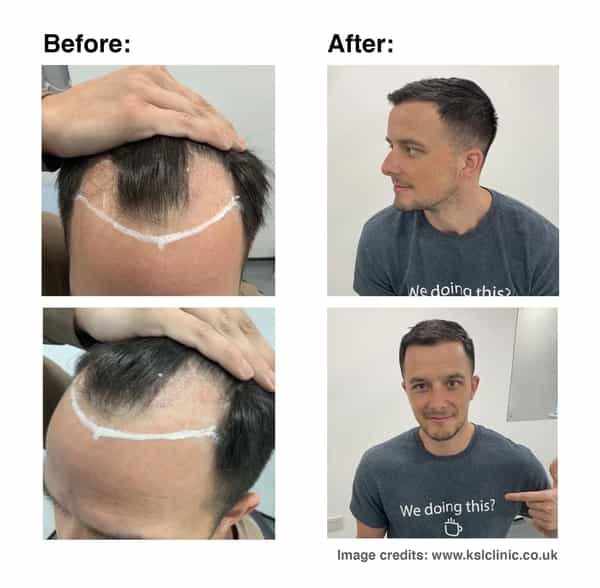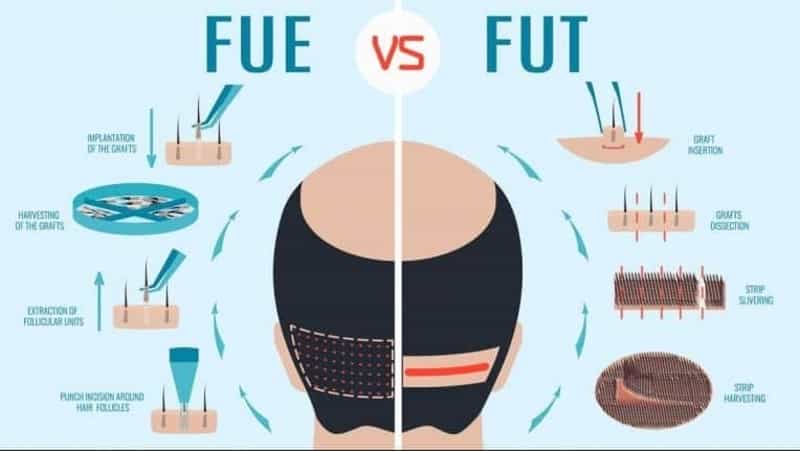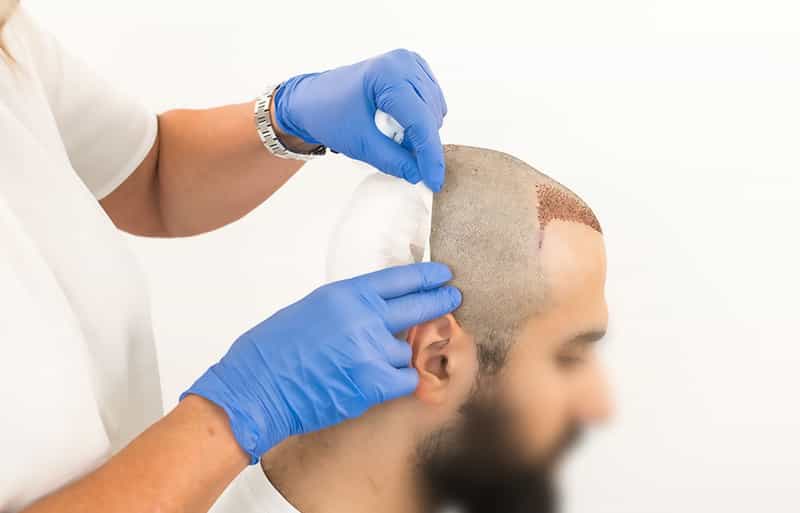Those dealing with hair loss understand how much it can affect confidence; so much so that in some extreme cases it can even deteriorate mental health. This is not a rare phenomenon. The truth is that most of us will have to deal with this issue in our lives: a staggering 80% of men and 50% of women experience significant hair loss during their lifetime.
Nowadays, we are lucky to have such a wide range of treatments and procedures at our disposal to slow down hair loss and improve our overall hair health. When all else fails, however, one highly effective, safe and relatively rapid way of restoring hair is by undergoing a hair transplant.
We’ve all seen the before and after images with incredible results such as this:

If you’re considering undergoing a hair transplant procedure, it’s important that you understand how it is done, how it works and what to expect. Today we are diving deeper into the what & how of hair transplants: preparation, what will happen during the procedure, tips to make the process smoother and recover more quickly with the best results possible.
Before: What you need to know & do before a hair transplant
Who is eligible for hair transplants?
Virtually anyone can get a hair transplant, whether they’re a man or a woman. If you are experiencing a receding hairline, premature balding, or hair thinning that you want to combat, and you have hair in other areas of your head, you should be eligible for a hair transplant.
Most people who go in for hair transplants are able to get them done; however, there are some cases in which you might have some issues proceeding, such as: if you don’t have good enough hair that could be used to transplant (in cases of baldness or alopecia), if your hair loss is caused by temporary issues (such as stress or radiation therapies) or if you are under 21 years of age.
In each of these cases, it’s best to consult with your doctor and see what their approach is and how they see your particular situation.
Which hair transplant method should you choose?
There are two main methods you can go for: FUT (Follicular Unit Transportation) and FUE (Follicular Unit Extraction). The main difference between the two is that with FUE your doctor would remove one hair follicle at a time (usually from the back and sides of your head) to transplant to your affected area, while with FUT, the doctor would take a patch of your hair follicles with a strip of skin, leaving a long scar at the back of your scalp. There are different advantages and disadvantages for FUE as opposed to FUT, but FUE is generally the one people go for.

Source: Feller & Blocham Medical.
Being realistic and aware of what happens afterwards
Of course, people who go in for a hair transplant are convinced by the promise of once again having a full head of hair. But as it is a surgical procedure, there are also other ways in which getting it done will impact your life.
For one, you need to be extremely committed to ensuring that the aftercare will be to your doctor’s specifications. This includes not touching your hair, not styling it or even not wearing anything on your hair for the first 3 months (more on this in the ‘After’ section of our article), as well as avoiding tobacco, excessive alcohol consumption amongst others.
While everyone hopes for the best results, it’s important to be realistic about how long it will take for the new hair to grow and how much a hair transplant can really achieve. In most cases, it takes a few months to see any results – and while it’s impossible to restore a full head of hair, hair transplantation can absolutely improve the aesthetics of your hair.
During: What to expect on the day of your hair transplant
When the big day comes, it’s important that you know what to expect. Your doctor will have hopefully shared with you everything you need to know from a medical perspective. The on-the-day procedure might change depending on what you choose to go for, and which clinic you decide to go with. Here are the answers to a few of your most common questions:
- Pain will be minimal: Before the operation, you will be given painkillers that will numb the pain, and during the procedure you should not be able to feel pain;
- You might feel a bit uncomfortable: After the operation, the area of your head from which hair was harvested will need to be covered with a patch, which might feel a bit uncomfortable;
- It won’t take too long: It depends on how large the transplanted area is, but an average FUE operation takes between 2-4 hours – which isn’t too long, considering the fact that the results will hopefully last a lifetime.
After: What to expect after your hair transplant
Possible complications of hair transplants
Getting hair transplants may sound like a light procedure, but at the end of the day it is surgery. Most people have a smooth process from start to finish – still, it’s good to be aware that the following can happen:
- Swelling: This is the most common side effect of hair transplants. Starting from the transplanted area on the scalp, the swelling can spread all the way down to your eyebrows. It can take up to a week to go away, so it might be a good idea to make sure you’ll be staying inside for the first week post-op;
- Redness: Because of the nature of the procedure, it can be quite traumatic to the scalp – which for most people results in some redness especially where the hair follicles are harvested and extracted. Not to worry – this is normal;
- Shock loss: One of the more severe complications, shock loss occurs when the hairs around the area that has been transplanted fall out. This can happen from the ‘shock’ of the surgery and the trauma it incurs. There are ways in which your doctor can help reduce this, and if you choose a good one you will most likely not have to deal with this;
- Numbness: The procedure is quite taxing on the scalp and its nerve endings, which may result in some numbness in certain areas. This is normal, and the sensation of numbness should dissipate over a few weeks or months;
- Bleeding: You may experience light bleeding both in your donor area and your transplanted area, but it should not last longer than one day;
- Infections: As the process of hair transplant involves creating many small trauma sites (one for each hair follicle), you will naturally be at a higher risk of infection. This is why it’s important to choose a hair transplant specialist who will take all the precautions and protect your health;
- Ingrown hair cyst: This can happen when the doctor accidentally pushes the hair further in rather than pull it out. With massage, compresses or antibiotics, this can be alleviated without further surgery.
Tips for best results
After your transplant, your hair will be most sensitive. For the first three months at least, you need to be prepared mentally and know that you will not be allowed to tamper with your hair in any way – and won’t be able to hide the potential redness or swelling with anything (neither hats, not hair styling). Here are a few of our best tips to ensuring that you get the best results possible:
- Protect your transplanted area: It’s crucial that you don’t hurt or tamper with your transplants after the procedure, not only hurting it but even avoiding touching it at all);
- Don’t wear a hat (or anything on your head!): Again, because of the hair being so sensitive it can affect your chances of the transplants ‘sticking’ and lasting;
- Don’t style your hair: For the first three months at least, you shouldn’t style your hair – the products and process of doing so can really damage your new hair;
- Use special shampoo: There are many products made especially for the post-transplant period that you can use, and the main idea around these is that they’re gentle on the scalp and hair, as well as not overly stripping.
If you can’t find one, opt for natural, safe and tested solutions like this hair strength shampoo.
Conclusion
For most people, hair transplants are a life-changing operation that can affect their entire lives, from self-confidence to career success. It is very rare that people find themselves in situations where they aren’t able to undergo the procedure, or face serious repercussions afterwards; in most cases, the process is smooth and painless.
While the recovery period of 3 months might seem very long to some, the truth is that it’s a small price to pay for what will (hopefully) be a lifetime of not worrying about thinning, balding or receding hair.
If you are considering getting a hair transplant yourself, make sure that you choose a verified doctor at a reputable clinic and prepare yourself diligently with plenty of information before moving forward.


